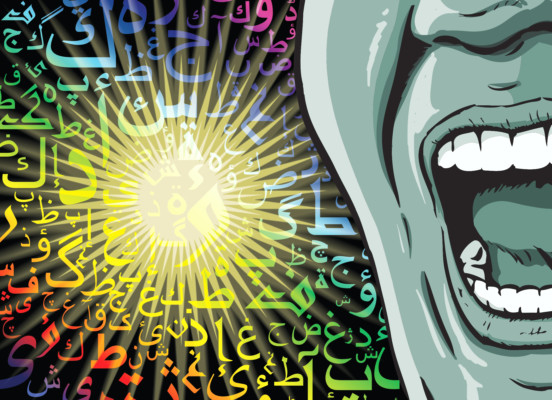
Unlike modern day Europe where we recognise that French and Portuguese are different languages, Arabs are not often sure and in many instances at odds, about how to describe “Arabic” today. While in Europe we call “French” and “Spanish” “languages”, in Arabic, linguistic and tonal variety are recognised as “dialects”, despite the lack of mutual perspicuity.
There’s a saying among linguists that “a language is a dialect with an army and a navy.” This means that languages without a state of their own are disparaged as mere jargons, slang or dialect. In Arabic, we see a rare case of the opposite problem: the Arabic language, spread over a vast region spanning more than 20 countries, has too many armies and navies.
The Arabic used in the Quran remains a prestigious and virtually unchanged standard throughout the Islamic world. Most Arabs consider this Quranic version to be true “Arabic”. Yet spoken languages aren’t immune to change and the test of time. As a result, the language used by Arabic speaking people on the streets and in their homes transformed in a myriad of ways in those 1,400 years (since the introduction of the Islamic text).
The spread of the Arabic language is aligned with the spread of Islam. The rise and expansion of Islam was not simply a religious or cultural conquest, but very much a linguistic conquest. Over the course of a century Arabic became both the official and the vernacular language of all Islamised countries in the Middle East. The prevailing tolerance on the part of the Muslim expansionists to Christians and Jews, Arabisation evolved at a much faster pace and indeed was a more complete process than the rate of Islamisation.
Many linguists take a more assertive stance, claiming Arabic “accents” are different languages. However, Arabs themselves consider Arabic a single entity, albeit with local variety. In academia and in schools, Arabs learn the Quranic-based language regionally known as Fusha, which linguists call “modern standard Arabic”. Fusha is used in official capacities such as political speeches, news broadcasts and all proper writing. Despite modern standard Arabic unequivocal use in formal faculties across the Middle East, nobody speaks it spontaneously in the marketplace or over the dinner table. Even the most advanced Arabic speakers may struggle to perfect writing and speaking Fusha correctly.
Standardisation
What exists in the Arabic language is a linguistic phenomenon known as “diglossia”. The term was introduced from French ‘diglossia’ by Charles Ferguson, who is academically credited with using this term in an article he published in 1959. Ferguson states that diglossia occurs when ‘one particular kind of standardisation where two varieties of a language exist side by side throughout the community, with each having a definite role to play.” In simpler terms, when two languages or language varieties exist side by side in a community, such as the Arabic dialect variety, and each one is used for different purposes, diglossia is apparent.
To put the Arabic language diglossia in perspective, we can compare the current state of Arabic language use to that of medieval Europe. Classical Latin was the only “official” language most people wrote and studied in, however “Latin” in the mouths of its orators had become early French, Spanish, and Portuguese depending on the region. In a scenario where a rural Moroccan and a rural Kuwaiti had to have a conversation and reliably understand one another, you will notice apparent confusion and overall struggle. An urban Algerian and an urban Syrian would also be challenged to understand each other, but might find ways to manage, notwithstanding a healthy dose of formal standard Arabic to smooth out misunderstandings and get the point across. In such cases, well known dialects such as Egyptian and Syrian, popularised through television and radio, can be utilised to fill in the gaps.
In the past, Pan-Arabist thinkers have called for codifying a “middle Arabic”, which would feature influences from the written standard, however simplified and stripped of much unnecessary complexity. Additionally, these non-traditionalists insist on including the most common dialectal features which would bridge the gap of linguistic dispersion. However, as it stands, there is no single authority to develop such a middle Arabic that would be accepted and recognised by all. Furthermore, the magnetism of pan-Arabism has waned due to recent political upheaval and emergent themes such as local nationalisms, pan-Islamism, the Shiite-Sunni sectarianism and a variety of other trends.
So, if a non-Arabic speaker were to embark on the journey of learning a top five spoken language that is Arabic, where would they start? Would they stick with the academic arena and learn Fusha, encompassing the ability to read and write? They might face mild ridicule when attempting to speak what they learned in informal settings. Some might not even completely understand the point being made.
Even though the Arabic diglossia issue causes complications for non-native learners and to native Arabic speakers alike, Arabic is an example of the birth and evolution of languages that challenges preconceived notions about good and bad speech. Furthermore, the relative importance and value of dialects becomes a theme that the learner must consider carefully. Elements in Arabic diglossia make the language inimitable and widely recognised as the second hardest language to learn.
Khalid Walid Saleh is a Palestinian American living and working in Dubai.









